There are quite a lot of diseases in tomatoes. They are more common in protected ground, although tomatoes on the streets also often get sick. In modern breeding, varieties have been bred that are relatively resistant to one disease or another, but there are very few tomatoes with complex resistance to a number of diseases.
| Contents: Tomato diseases and their treatment
|
Late blight
The most common and very dangerous disease of tomatoes, which is very difficult to treat. It appears both in the greenhouse and outdoors. The causative agent is a pathogenic fungus whose spores persist on plant debris and in the soil. There are several varieties of the pathogen, all of them infect plants of the Solanaceae family.
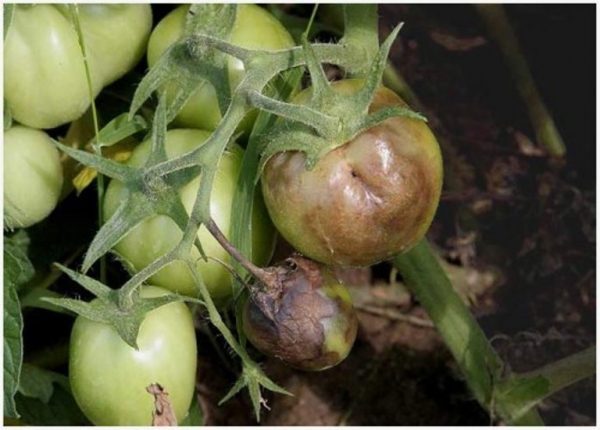
This is what tomatoes with late blight look like.
In the photo there are tomatoes with late blight
Infection can occur at any time during the growing season, but most often the disease appears in the second half of summer. The main source of infection in dachas is affected potatoes and long-term cultivation of tomatoes in one place for many years (this especially applies to greenhouses).
Conditions for the development of the disease
The most important factor in the development of late blight is high humidity. Tomatoes are especially often affected in greenhouses when combined growing with cucumbersthat require high humidity. Other reasons are:
- poor ventilation and air stagnation in the greenhouse;
- close location of potatoes. In open ground, the disease begins to appear simultaneously on both tomatoes and potatoes;
- sudden changes in temperature;
- rainy and humid weather;
- irrigation by sprinkling;
- lack of microelements (especially copper) in feeding.
In hot summers, late blight spreads less, although it will not be possible to completely protect tomatoes and potatoes from it.
Description of the disease
It affects stems, petioles, leaves, flowers and fruits, especially green ones.Brown spots appear along the edges of the leaves without clear boundaries. A whitish coating forms on the underside.
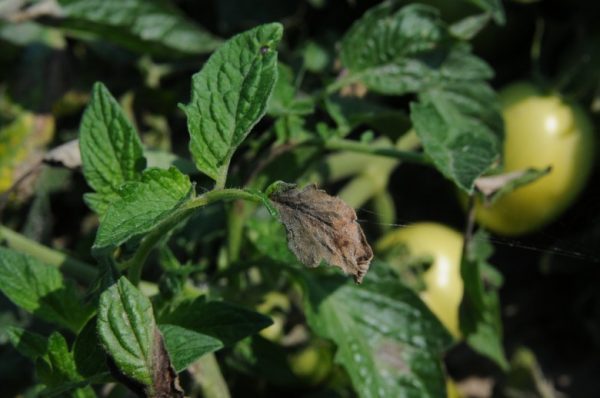
Tomato leaves affected by late blight.
Brown-brown stripes appear on the stems and petioles. Gradually growing, the streaks turn into irregularly shaped spots encircling the stems and petioles in a circle.
On fruits, especially green ones, less often in the technical ripeness phase, dark, brown-brown-black dry hard spots appear, which grow very quickly and affect the entire fruit. It becomes unsuitable for either food or processing.
Affected flowers turn brown and fall off without setting fruit. If the ovaries do appear, they quickly turn black and crumble.
Late blight has an incubation period of 3-5 days, depending on the weather. It spreads very quickly. Once it appears on a plot, it is impossible to prevent its further spread.
How to treat the disease
At the same time as tomatoes, potatoes, as well as peppers and eggplants should be processed. Potatoes, as a rule, are the first to be affected by late blight and are a source of infection for all other crops.
Treatment of the disease is effective only in the initial period. You can delay the development of the disease for 14-18 days, but completely get rid of late blight on tomatoes and potatoes won't work. Peppers and eggplants are much less affected and with timely processing they can be protected from the disease.
- Treatment of tomatoes and potatoes with copper-containing preparations: HOM, Ordan, Bordeaux mixture, copper sulfate, Kuproksat.
- Spray the soil under the tomatoes with solutions of the same preparations. Copper reduces the activity of the pathogen, so the treated plants will remain healthy for some time, while the diseased ones have already been removed from the site.The period of protective action in a greenhouse is 12-16 days, outdoors - 7-10 days. Therefore, the frequency of processing tomatoes (and potatoes) in open ground is 4-6 times per season. In greenhouses, spraying is carried out three times.
- Watering at the root with Previkur Energy. The drug contains two active components and has a broad effect on a number of pathogens. During the season, 3-4 waterings are carried out.
- Spraying with Consento. He is similar to Previkur. Plants are treated 4 times during the growing season with an interval of 10 days. It is advisable to alternate treatment with Previkur or Consento with spraying of crops with copper preparations.
- When the disease spreads through tomato and potato bushes, diseased leaves are removed and the plants are sprayed with a 1% calcium chloride solution. Spraying is carried out very carefully, treating the stem, stalk and leaves from the top and bottom. Calcium chloride solution is sold in pharmacies. For treatment, take a 10% solution with a volume of 200 ml, which is then diluted in two liters of water.
The first treatment with any drug is carried out prophylactically.
When late blight appears, it is too late to treat tomatoes from this disease. In this case, it is much easier to delay the appearance of late blight than to fight it unsuccessfully later.
Disease prevention
Prevention is the most important thing in the fight against late blight.
- 5-7 days after planting the seedlings, the tomatoes are treated with Fitosporin. Subsequently, spraying is carried out once every 7 days. Sprinkle the soil with a solution of Fitosporin.
- Since copper inhibits the development of pathogen spores, copper wire is wrapped around the stem.
- Regularly ventilate greenhouses, avoiding an increase in humidity in them.
- Remove lower leaves in a timely manner. First they are cut off under the first flower cluster, then under the second, etc.
- When late blight appears in a neighboring area or on potatoes at your own dacha, unripe fruits are removed, treated in a warm (40°C) pink solution of potassium permanganate and left to ripen.
- Growing varieties resistant to late blight: Anyuta.
Folk remedies for treating late blight
The only effective remedy prevention and treatment of the disease in the earliest period is to treat the bushes with iodine solution. 10 ml of a 5% iodine solution is diluted in 10 liters of water and sprayed on the plants every 3-5 days. You can add 1 liter of milk to the prepared solution. It creates a film on the surface of the bushes, thereby preventing the penetration of the pathogen into the tissue.
Mosaic
The disease is caused by the tomato or tobacco mosaic virus. When grown together with cucumbers, tomatoes are affected by the cucumber mosaic virus. If potatoes grow nearby, the mosaic can be caused by the potato X virus. These viruses generally infect most nightshade crops, as well as many plants grown together with tomatoes.
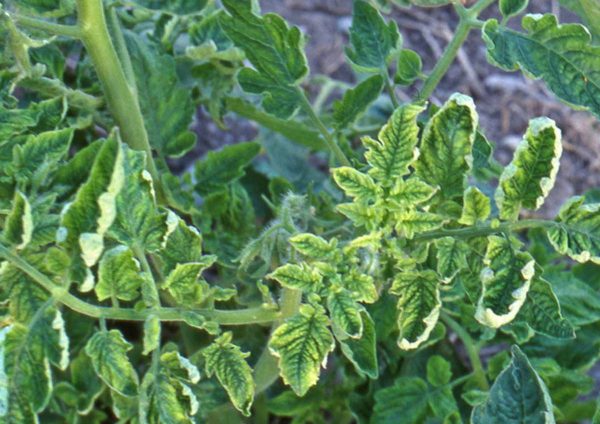
Mosaic on tomato leaves.
Photo of mosaic
Viruses are transmitted from one plant to another by wind, airborne droplets, contact, and seeds. Viral diseases are very harmful. Yield loss reaches 50-70%. More often appears in the second half of summer. Viruses are very resistant to environmental factors. Can be stored in seeds and on plant debris for 22 months.
Description of the disease
The disease on tomatoes can appear in two forms.
- Enational defeat.Yellow spots of a vague shape appear on the leaves, the leaf becomes speckled. The leaves themselves become lighter, stop growing, and take on a thread-like shape. Sometimes the edges of the leaves acquire a serrated shape, becoming similar to a fern leaf. The leaves gradually curl and dry out. A distinctive feature of this type of mosaic is the growth of special outgrowths on the underside of the leaves, similar to either a new petiole or a new young leaf. The length of the neoplasms is no more than 1 cm. This type of mosaic is very harmful.
- Mixed infection, when plants are affected by several types of viruses at once. Streaks appear on the stems, petioles and fruits. They can be wide and narrow, long and short. Such a defeat is called streak or striation. The streaks are lighter than the surrounding tissue and represent dead areas of the skin. When dead areas appear on the fruit, their skin bursts and the internal contents turn out.
How to treat the disease
- If the enotic form appears, diseased plants are immediately removed. The rest are sprayed with Farmayod.
- Maintaining temperature conditions, especially in greenhouses. The disease begins to manifest itself at temperatures above 28°C for more than 5-7 days. Therefore, a draft must be created in greenhouses. Correct temperature conditions prevent viruses from developing.
- Treatment of tomatoes with Farmayod. After treatment, no concentrate should form in the greenhouse, and in open ground it is advisable that there is no rain for 3-4 days, since the preparation is very easily washed off.
If, despite all the measures taken, the disease progresses, the affected plants and their parts are removed, and the rest are treated.
Prevention
- Before sowing, be sure to warm the seeds.
- Disinfection of greenhouses.
- Removal of plant residues.
- Growing hybrids that have genetic resistance to mosaic. True, the taste of hybrids is not up to par. These include: Our Masha, Funtik, Snow White, Melody.
But in fact, prevention is a weak defense against viruses. The pathogen can enter the crop from anywhere, especially if potatoes and cucumbers grow nearby.
Yellow curl
A viral disease caused by the tomato yellow curl virus. The virus is transmitted by greenhouse whiteflies or aphids, if it moves from a diseased bush to a healthy one. The virus does not spread in other ways. The harmfulness of this disease on tomatoes depends on the degree of damage: in mild cases, the yield loss is 15-20%, in severe cases the crop is completely lost.
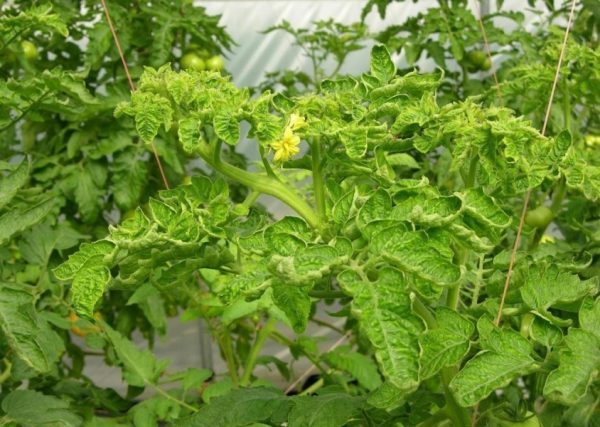
The photo shows a tomato bush affected by yellow curl.
Damage can occur at any period of the growing season, starting from planting seedlings in a greenhouse.
Yellow curl in the photo
Description of the disease
- The color of tomato leaves changes: from dark green it becomes yellowish. Sometimes yellowness appears only along the edge of the leaf blade, while the central vein remains its normal color.
- The leaves at the top become curly. Young leaves become small and immediately curl.
- Tomatoes don't grow well.
- Fall of flowers.
- The set fruits are small, hard, ribbed, and do not grow.
How to deal with yellow curl
Control measures are rather preventative and aimed at preventing the onset of the disease.
- If the bush is infected, then it cannot be cured. To prevent further spread of the disease, tomatoes are dug up and burned. Tops cannot be composted because the virus persists in them for several years.
- Destruction of whiteflies and aphids. The drugs used are Aktara, Iskra, Actellik.
- When growing tomatoes in a greenhouse, it is constantly ventilated, avoiding high humidity. Humidity above 80% promotes infection and rapid development of any viral diseases, including yellow curl.
Disease prevention
When whiteflies appear, tomatoes are sprayed prophylactically with Farmayod. Treatment is carried out during the flight of butterflies, usually a double treatment at intervals of 10 days.
Greenhouse tomatoes are susceptible to the disease. Rarely found in open ground.
Cladosporiosis or brown spot
The causative agent is a pathogenic fungus. This disease is very common in greenhouses and, along with late blight, is one of the most harmful diseases of tomatoes. The pathogen overwinters in the soil, on plant debris, and seeds obtained from infected plants. Under favorable conditions, it can be stored in greenhouses for up to 10 years.
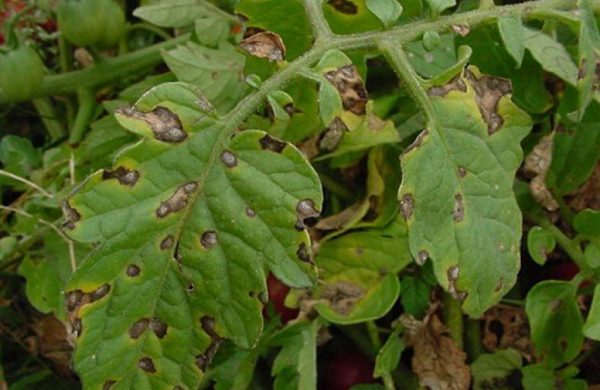
Brown spots on tomato leaves are a sign of disease.
Spores are spread by wind and water when watering and caring for tomatoes. The pathogen can withstand prolonged freezing and heating.
Photo of cladosporiosis
Conditions for the development of the disease
Favorable conditions for the development of cladosporiosis are humidity above 90% and temperature 22-25 °C. The disease is common in unheated greenhouses, especially when grown together with cucumbers. In the northern regions it appears in the second half of summer, in the southern regions - mainly in the initial growing season.
Description of the disease
Leaves are affected.
- The disease first appears on the lower leaves. Velvety, blurry spots of light gray color appear on the underside, then turning brown.
- Later, light green spots appear on the upper side of the leaves, gradually turning yellow and then turning brown. They have a round shape, 0.5-1 cm in diameter.
- The disease spreads very quickly throughout the bush and throughout the plot. Affected leaves dry out. A diseased bush may lose all its leaf mass within 7-10 days. The plant dies.
- If left untreated, fruits are sometimes affected. They wrinkle and gradually dry out on the bushes.
Treatment of the disease
- Cross-ventilation of greenhouses. Humidity should not be allowed to exceed 80%. There must be constant air circulation in the greenhouse.
- At the very beginning of the disease, spray the leaves with biological preparations Fitosporin or Pseudobacterin. Treatments are carried out throughout the growing season with an interval of 7-10 days. They are especially necessary when growing tomatoes and cucumbers in the same greenhouse.
- When the disease develops, treatment is carried out with copper-containing drugs: Abiga-Pik, HOM, Ordan.
Compliance with agrotechnical requirements when growing tomatoes is a reliable means of protection against cladosporiosis.
Traditional methods of treatment
- The best remedy is whey (1 l / 10 l of water).Lactic bacteria suppress the development of pathogenic microflora.
- Spraying bushes with a pink solution of potassium permanganate.
Folk remedies are good for preventing the disease. But they are of little use for treating tomato diseases.
Prevention
- Removing the lower leaves as the tassels are tied.
- Growing varieties resistant to cladosporiosis: Nasha Masha, Tolstoy, Funtik, Waltz, Obzhorka.
Cladosporiosis practically does not affect tomatoes grown in open ground.
Powdery mildew
Powdery mildew distributed mainly in glass greenhouses. In film and polycarbonate structures, the disease practically does not occur on tomatoes. Distributed in the southern regions of the country, it is rare in the middle zone and to the north.
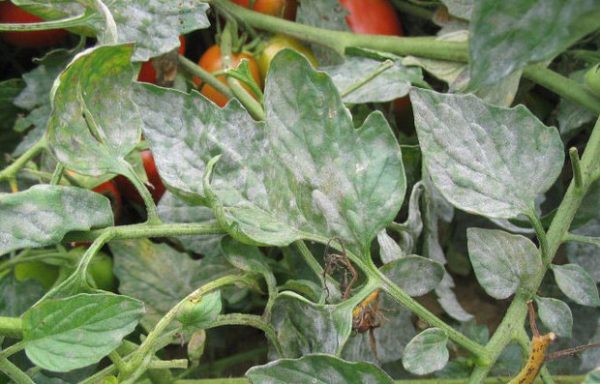
Powdery mildew on tomatoes.
The causative agents are pathogenic fungi oidium or oidiopsis. The parasite persists on weeds, especially thistle. In addition to tomatoes, the infection can spread to cucumbers, peppers, eggplants, and grapes. In the south, the disease appears very early, usually immediately after planting seedlings and throughout the first half of the growing season. In central regions, powdery mildew attacks tomatoes in late summer. Crop losses are possible only in the complete absence of protective measures.
Photo of powdery mildew
Factors influencing the occurrence of the disease
Powdery mildew appears on tomatoes in relatively cool weather (15-20°C) and high air humidity. If the humidity in protected soil exceeds 90%, then powdery mildew may appear at a temperature of 20-30°C. The pathogen spreads with air currents.
Description of the disease
Since the disease on tomatoes is caused by different types of fungi, the manifestations may vary.
- A white powdery coating appears on the upper side of the leaves. At first it appears in the form of separate spots, which quickly merge.
- A white powdery coating appears on the underside, and light green or yellowish spots appear on top. Subsequently, a white coating appears on the upper side of the leaves.
- Gradually the spots spread over the entire leaf.
- The leaves dry out and the plant dies.
These types of pathogens also affect gooseberries, grapes, and black currants. If tomatoes grow near these crops, they can get sick.
How to treat the disease
- Constantly ventilate the greenhouse, avoiding excess humidity.
- When the disease appears, the bushes are treated with Topaz, HOM, Ordan.
- In case of severe damage, use the drug Tiovit Jet. At the same time as the tomatoes, nearby currant, gooseberry and grape bushes are processed. Treatment is carried out 2 times with an interval of 5-7 days.
Powdery mildew on tomatoes is not as harmful as on gooseberries or currants. It can be treated well if timely measures are taken.
Traditional methods of treating powdery mildew
Folk remedies are preventive. By using them, the disease can be prevented, but tomatoes cannot be cured.
- Treatment of bushes with iodine solution (10 ml/10 l of water). Iodine protects tomatoes well from many diseases. Spray during the entire growing season with an interval of 10 days.
- Spraying the crop with a solution of sodium humate. This method is not yet widely used, but in the experiment it showed good results.The growth of the mycelium either slows down (at a late stage of disease development) or stops completely (at the initial stage).
- For preventive purposes and in the earliest period of the disease, tomatoes are sprayed with a raspberry solution of potassium permanganate.
Usually, folk measures are enough to prevent the development of the disease.
Prevention
- It is not advisable to plant tomatoes and cucumbers in greenhouses; the crops require different growing conditions. Although the pathogens that cause powdery mildew in tomatoes and cucumbers are different, with high humidity it can appear on both crops.
- Treatment with the biological product Fitosporin.
- Growing varieties resistant to powdery mildew: Bomax, Tolstoy.
Rot on tomatoes
Apical rot
There is no consensus on blossom end rot. Some consider it a non-infectious disease, others - a violation of agricultural cultivation techniques. The disease most often affects tomatoes in a greenhouse, but is rare outdoors.
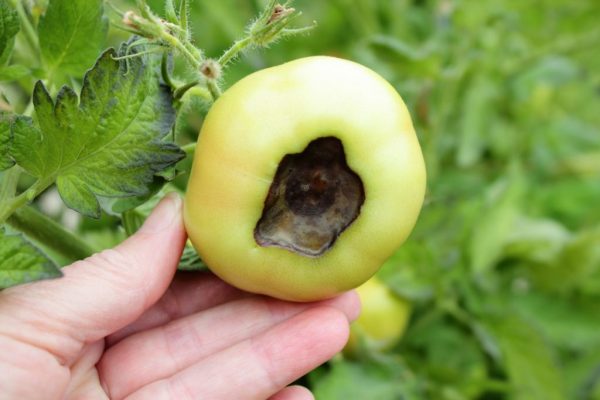
The photo shows a tomato affected by blossom end rot.
Photo of blossom end rot
Causes of blossom end rot
The main reason is the lack of moisture and nutrients in the soil, especially calcium. Top rot mainly appears at high air temperatures.
At high temperatures and lack of moisture in the soil, the flow of water and nutrients to the fruits stops, and during severe and prolonged drought, the bushes begin to take it from the fruits and direct it to the growth point.As a result, the cells closest to the stalk die and a patch of dead tissue (spot) appears.
Description of the disease
Blossom rot appears only on green fruits. The fruits of the lower three clusters are especially susceptible to it.
- A dark, watery green spot appears at the top of the fruit (where the flower was) and quickly darkens.
- After a few days, the spot acquires a gray-brown tint and clearly stands out against the background of the light green tissue of the fruit.
- The fruit becomes deformed, the tissue falls in and becomes hard.
- A section of the fruit clearly shows darkening of the internal tissues.
Affected tomatoes ripen quickly. Sometimes the disease occurs in a latent form, without outwardly manifesting itself. And only on the cut can you see the problem. Large-fruited varieties are more likely to suffer from blossom-end rot.
How is the disease treated?
Spraying or watering tomatoes with calcium nitrate. 7-10 g of fertilizer is dissolved in 10 liters of water. If there are no signs of rot, then there is no need to spray the tomatoes, since excess calcium in the plant leads to the unripening of the top of the fruit; it remains green.
Prevention
In hot weather, bushes are watered more often with sufficient water.
There are varieties of tomatoes that, even in unfavorable conditions, are not affected by blossom end rot: Granddaughter's Love, Delicatessen.
Gray rot
The causative agent is a pathogenic fungus. The spores of the fungus are very light and airy, easily spread by the wind, as well as by water when watering. Can be stored for a long time on plant debris.
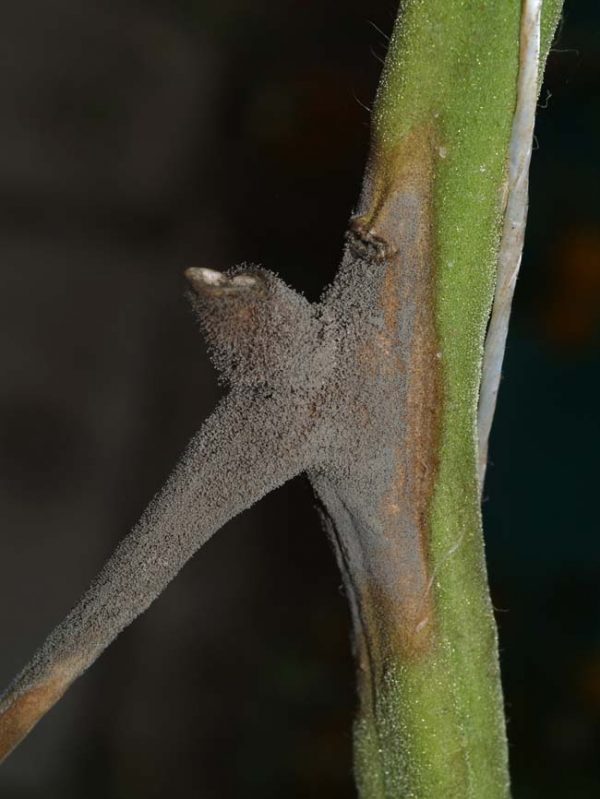
Gray rot on a tomato stem.
Factors contributing to the appearance of gray mold
Spores enter the plant through wounds when caring for tomatoes or harvesting fruits. It is mainly greenhouse tomatoes that suffer. The disease spreads quickly throughout the greenhouse.Tomatoes are affected during the fruiting period; young, bushes without ovaries are resistant to the pathogen.
The disease affects fruits, inflorescences, and shoot tips. In the absence of protective measures, plants die. Spreads at high air humidity.
Description of the disease
- Gray-brown spots with a gray fluffy coating appear on the stems, petioles of fruits and clusters.
- After 4-5 days, the spots grow, covering the perimeter of the stem. Gradually, the center of the spot turns yellow, and sporulation of the fungus begins.
- Necrosis of the conducting vessels develops in the affected area, causing the leaves to wither and dry out.
- Round gray-white spots with a fluffy coating appear on the fruits. The fruits, as a rule, crack and become unsuitable for food and processing.
The photo shows tomato leaves and fruits affected by gray rot.
Treatment of the disease
- In the initial stages of the disease, treating bushes with Trichoderma is very effective. The bacteria contained in the preparation are antagonists of the pathogen and destroy its mycelium. Spray tomatoes 2-3 times per season with an interval of 10 days.
- Treatment with Alirin B, Planriz.
- Maintaining low air humidity in the greenhouse.
Spraying of tomatoes is carried out in the morning or in the afternoon so that the bushes have time to dry completely by night.
Traditional methods of treating tomatoes from gray rot
- The most effective way is to completely spray tomatoes and crops grown with them with an iodine solution. 10 ml of 5% iodine is dissolved in 10 liters of water and treated. Repeated spraying after 10 days.
- Treatment with tar solution. 40 ml of liquid or 20 g of solid tar soap are diluted in 10 liters of water and sprayed on the bushes. During the season, 3 treatments are carried out.Since a new relapse of the disease occurs after 12-15 days, the interval between treatments is no more than 10 days.
- Spraying bushes with a pink solution of potassium permanganate.
Preventive measures
Prevention in the fight against gray mold is very effective. Properly performed preventive measures can completely eliminate the development of the disease.
- Maintaining humidity in the greenhouse no higher than 65-70%.
- Regular ventilation of the greenhouse even in damp and cold weather.
- Timely and complete removal of plant residues.
- Pruning leaves and collecting fruits is carried out only in dry weather. After watering, the soil under the tomatoes should dry out.
- Do not sprinkle water on tomatoes.
- If tomatoes are damaged when caring for them or a large number of leaves are removed at a time, the bushes are pollinated with tobacco dust or ash.
It is much easier to prevent a disease than to treat it later.
White rot
The causative agent is the pathogenic fungus sclerotinia. The disease affects all crops grown together with tomatoes in the same greenhouse. All above-ground organs of the plant are affected, including ripe fruits. During the growing season, the damage from the disease is insignificant, but during ripening and storage you can lose 50-70% of the harvest.
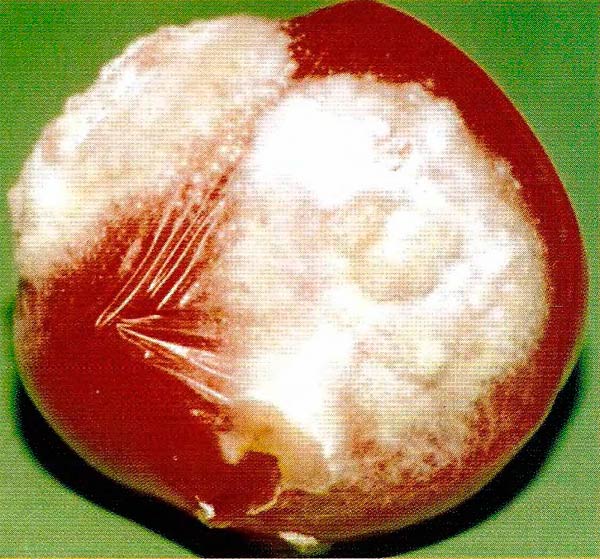
White rot.
Conditions for the occurrence of the disease
The main factor is increased air humidity. The fungus persists on plant debris and in soil. Greenhouse tomatoes are most susceptible to the disease. It is practically not found in open ground.
Signs of defeat
- A wet, fluffy white coating appears in the form of round spots on the stems, leaves, fruits, and petioles.
- The affected tissue becomes slimy and softens.
- After a few days, black dots appear on the spots - this is sporulation of the fungus.
- During storage, white rot appears in places where tomatoes are damaged: microcracks, places of cracking.
Treatment of white rot
- When signs of disease appear, tomatoes are sprayed with copper-containing preparations: HOM, Ordan, Kuproksat.
- Affected leaves and fruits are torn off and burned.
- The white coating is removed from the stem, and the damaged area is sprinkled with copper sulfate powder, ash, and chalk.
- If rot appears during storage, the diseased tomatoes are removed, the rest are sprayed with a solution of potassium permanganate, and then thoroughly dried in the sun. If the harvest is large, then the tomatoes are sprinkled with ash and processed as quickly as possible. Or each tomato is wrapped in paper.
Folk remedies are more preventative than curative:
- Spraying with milk (1 l/10 l of water). Lactic bacteria suppress the development of sclerotinia.
- In humid weather, treat tomatoes with a pink solution of potassium permanganate every 7-10 days.
Prevention
- The best prevention white and gray rot - this is good ventilation of greenhouses. They are ventilated daily. Even on cold nights, the windows are left open, since tomatoes can withstand temperatures of 6-8°C without any damage.
- Remove lower leaves and fallen fruits in a timely manner, since they are the source of infection.
- If in previous years there was white rot in the greenhouse, then disinfection is carried out before planting seedlings.
As in the case of gray mold, it is easier to prevent the disease than to fight it.
Brown rot or fomoz
A fungal disease caused by a pathogenic fungus. It only affects fruits. Preserves in soil and on fallen tomatoes. Transported by wind and water. Potatoes are affected, so if one of the crops becomes infected, measures are taken to protect both tomatoes and potatoes.
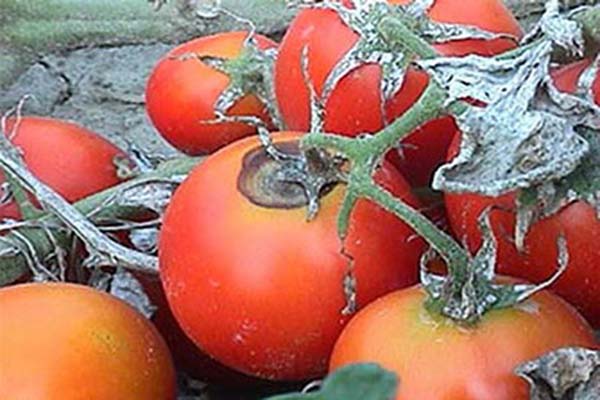
In the photo there are tomatoes sick with Phoma or brown rot.
Conditions for the appearance of brown rot
It is most often found in greenhouses, although it can also occur in open ground. The appearance factors are high air humidity and high nitrogen content in the fertilizer. The fungus penetrates the fruit through microdamages in the skin near the stalk.
Description of the disease
- A brown spot appears at the base of the tomato near the stalk.
- Gradually, the spot evenly increases, reaching a size of 3-4 cm, but never covers the entire fruit.
- The skin wrinkles and falls in. The fruit becomes lumpy and easily squeezed.
- The internal tissues of the fetus rot. Tomatoes become unfit for food.
- Affected green tomatoes fall off without ripening.
Treatment of diseased tomatoes
- Affected fruits are collected and burned.
- The rest are treated with HOM or Ordan.
- Stop fertilizing containing large amounts of nitrogen. Feed the bushes with microfertilizers.
- Ventilate the greenhouse regularly, leaving it open at night in warm weather.
Prevention consists of maintaining normal humidity and balanced feeding. With proper agricultural technology, tomatoes are not affected by Phoma.
Root rot
The disease is caused by a number of pathogenic fungi that live in the soil. Typically, tomatoes get sick in very wet summers when there is no drainage in the garden bed, or when the crop is grown on waterlogged soils. Affects tomatoes throughout the growing season. Sick plants die.
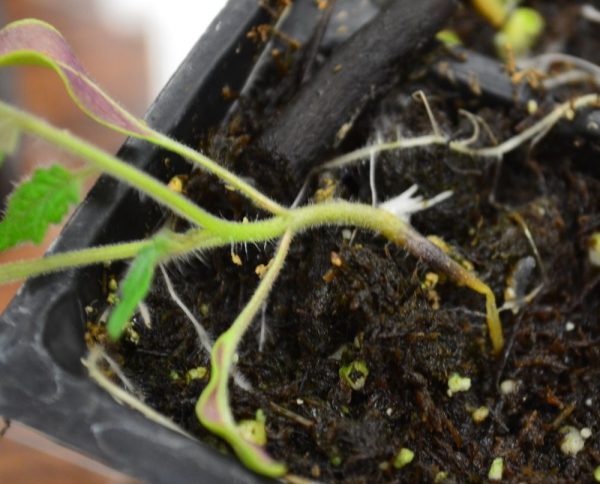
Root rot on tomatoes.
The infection penetrates the tissue only through damage to the root collar or roots. Spread is facilitated by planting seedlings in cold soil or very sharp temperature fluctuations.
Description of the disease
Signs of damage depend on the pathogen parasitizing the roots.
- The root collar softens and rots.
- The roots turn brown and plaque appears on them.
- Conducting vessels become clogged and nutrient transport is disrupted.
- Sometimes a pink or white coating appears on the root collar.
How to treat tomatoes
- Watering the bushes at the root with Pseudobacterin or Trichoderma.
- If root rot has appeared on the plot, then after harvesting the plant residues, the soil is spilled with boiling water. Root rot is very persistent and affects many types of cultivated plants, so steaming the soil must be done.
- Water the plants with Previkur 2-3 times per season with an interval of 10 days.
- If root rot has spread widely, water the bed with tomatoes with the preparation Maxim Dachanik. The consumption of the working solution is 1.5 l per plant. Watering is carried out strictly at the root.
- In serious cases, water the roots with a solution of colloidal sulfur or a drug based on it, Tiovit Jet.
Root rots, if they appear, cause great damage not so much to tomatoes, but to subsequent crops in crop rotation.
Folk remedies. For prevention, water the plants with a solution of iodine or potassium permanganate of raspberry color. First remove the top layer of soil to expose the root collar. It is sprayed with the same solutions.
Disease prevention
Prevention consists of maintaining optimal soil moisture. When growing tomatoes on waterlogged lands, be sure to create a system for removing excess moisture.
There are varieties resistant to root rot: Vnuchkina Lyubov, Delikates, Vovchik, Melodiya, Azhur, Galina, Bogata Khata.
Stem necrosis
This is a bacterial disease of tomatoes and potatoes. The causative agent is the bacterium Pseudomonas. The disease is very harmful; affected tomatoes die. The disease on tomatoes appears at the beginning of fruiting. The infection is transmitted by seeds. It is transferred when caring for plants, with irrigation water and air currents.
Preserved on seeds and plant debris.After infection, the disease does not appear for a long time. The incubation period of the disease is 18 days.
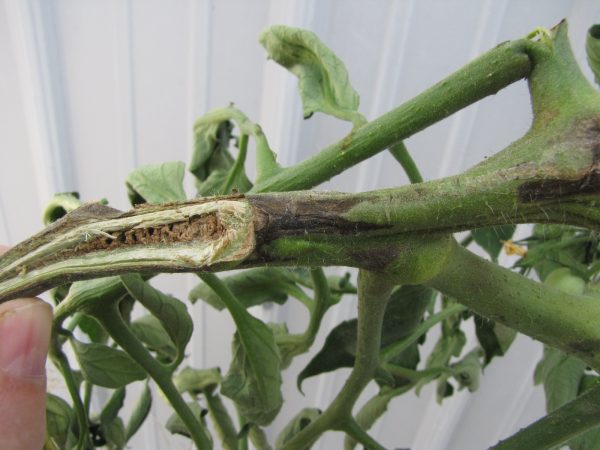
The photo shows necrosis of a tomato stem
Description of the disease
Tall varieties are affected first. Usually infection occurs during the formation of the first brush.
- Elongated brown spots appear on the lower part of the stem; they are slightly pressed into the tissue.
- Colonies of bacteria accumulate in conducting vessels.
- When the bacterial mass exceeds a critical level, the stem bursts and a whitish-cream liquid containing living bacteria flows out of the wounds.
- A longitudinal section of the stem reveals, depending on the stage of the disease, a glassy, darkened or, at a later stage, a dried core.
- A network of lightened veins appears on the fruits. It also persists when tomatoes ripen.
- When the bushes are shaken, the affected fruits fall off.
- Seeds in diseased fruits are affected. Their shell becomes necrotic, spots appear on it, or the seed becomes deformed. These tomatoes should not be eaten.
- The top of the plant darkens and loses turgor.
- The plant withers and dies.
Externally, the tomatoes look completely healthy. The only thing that might alert you is the appearance of a large number of aerial roots at the bottom of the stem. Those who examine the bushes very carefully may notice numerous cracks on the stem a little earlier at a height of no more than 20 cm from the ground.
There is no effective treatment for the disease during the growing season. The plants are completely removed along with a lump of earth. The soil is sprinkled with bleach or watered with a solution of Fitolavin-300.
Preventive measures include thoroughly treating the seeds before sowing. The most effective is heating the seeds in a solution of potassium permanganate. Bacteria die at temperatures above 40°C.
No varieties resistant to stem necrosis have been developed. There is a Red Arrow hybrid that is tolerant to the disease (that is, it is very weakly affected).
Continuation of the topic:
- The most dangerous diseases of cucumbers and methods of treating them
- How to feed tomatoes to get a rich harvest
- How to properly pick tomatoes and why you need to do it
- What to do if tomato leaves curl.
- Varieties of pink tomatoes and reviews from gardeners about these varieties.
- Secrets of growing tomato Bull's heart.
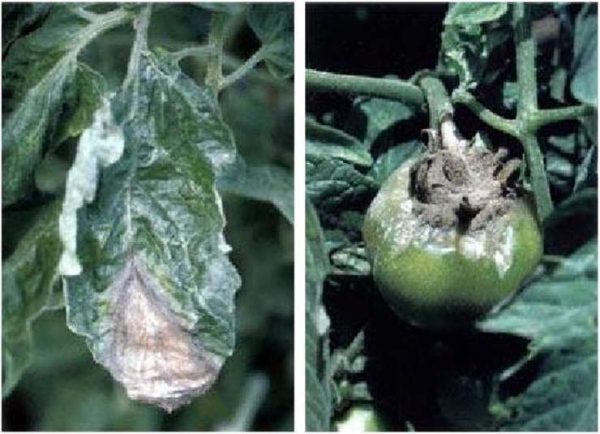


 (8 ratings, average: 4,88 out of 5)
(8 ratings, average: 4,88 out of 5) CUCUMBERS NEVER GET SICK, I'VE BEEN USING ONLY THIS FOR 40 YEARS! I SHARE A SECRET WITH YOU, CUCUMBERS ARE LIKE THE PICTURE!
CUCUMBERS NEVER GET SICK, I'VE BEEN USING ONLY THIS FOR 40 YEARS! I SHARE A SECRET WITH YOU, CUCUMBERS ARE LIKE THE PICTURE! You can dig a bucket of potatoes from each bush. Do you think these are fairy tales? Watch the video
You can dig a bucket of potatoes from each bush. Do you think these are fairy tales? Watch the video
 How our fellow gardeners work in Korea. There is a lot to learn and just fun to watch.
How our fellow gardeners work in Korea. There is a lot to learn and just fun to watch. Eye trainer. The author claims that with daily viewing, vision is restored. They don't charge money for views.
Eye trainer. The author claims that with daily viewing, vision is restored. They don't charge money for views. A 3-ingredient cake recipe in 30 minutes is better than Napoleon. Simple and very tasty.
A 3-ingredient cake recipe in 30 minutes is better than Napoleon. Simple and very tasty. Therapeutic exercises for cervical osteochondrosis. A complete set of exercises.
Therapeutic exercises for cervical osteochondrosis. A complete set of exercises. Which indoor plants match your zodiac sign?
Which indoor plants match your zodiac sign? What about them? Excursion to German dachas.
What about them? Excursion to German dachas.
Can tomato seedlings get late blight?
Tomato seedlings can get late blight, but in practice this happens quite rarely.
If the seedlings do get sick, then how to treat them and if there is any point in doing so.
There is no point in treating seedlings for late blight; it cannot be cured anyway. Such seedlings must be thrown away immediately.
Late blight can be cured on seedlings. Last year I sprayed it 2 or 3 times with Abiga-Pik and everything went away.
Tatyana, are you sure that the seedlings were affected by late blight? How easy and simple it all worked out for you.
Spots appeared on the leaves, the kind of spots I saw in photographs with late blight. I started spraying the seedlings with Abiga Peak and after some time everything went away.
Tatyana, spots on the leaves of tomato seedlings can appear for many reasons, from sunburn, from wind. Late blight appears very rarely on tomato seedlings; there must be special reasons for this. For example, in the room where the seedlings are located, potatoes affected by late blight were germinated. There must be some source of infection.
I have been growing tomato seedlings for 30 years now and they have never suffered from late blight. Here in the beds, yes, there’s real trouble with it.
Good article, thanks. Now I will treat my tomatoes according to your recommendations.
And thank you, Irina, for your kind words. It would be better if you never needed these recommendations.
And I’ve just been tormented by rot on tomatoes for about 5 years now. And I don’t understand what kind of rot it is: white, gray or gray-brown.
Trichoderma helps well against all types of rot.
If you have blossom end rot on your tomatoes, you need to do the following:
-remove some of the lower leaves
-increase watering not only the amount of water, but also the frequency of watering.
-feed at the root with calcium nitrate (1 tablespoon per 10 liters of water, about 1 liter at the root) or a leaf (2 grams per 1 liter of water). Calcium chloride 5 ml helps very well. for 1l. water.
I have spots on my tomato leaves. Is this late blight or could it be some other disease and what should I do now? The main thing is how to find out what is wrong with tomatoes?
Shurochka, if the spots are only on the leaves, then most likely it is cladosporiosis. With late blight, both leaves and stems are affected, and then the fruits. The article contains photos of these diseases and methods of treatment.
Last year I developed blossom end rot, and on the advice of a neighbor, I sprayed my tomatoes with a decoction of oak bark. I prepared the decoction like this:
5 gr. oak bark (pharmaceutical) poured cold water (2 liters), brought to a boil and boiled for 10 minutes. Then I cooled it, strained it, brought the solution to 10 liters and sprayed the tomatoes. I haven’t seen the top again, and not this year either.